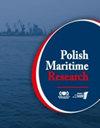考虑运行姿态变化的简化平面艇转向操纵仿真
IF 2
3区 工程技术
Q2 ENGINEERING, MARINE
引用次数: 1
摘要
摘要滑行艇操纵的建模和仿真需要耦合的六自由度(6自由度)运动方程。一个耦合的6自由度运动方程需要数百个操纵流体动力学系数(MHC),这些系数大多是通过平面运动机构(PMM)测试确定的。除非对运动方程进行某种简化,否则测试运行的次数太多。本研究将6自由度运动方程修改为4+2自由度运动方程式,其中垂荡和俯仰方程分别用动态吃水和纵倾(即所谓的运行姿态)代替。该方法适用于在滑行状态下开始并在同一状态下结束的机动。在此基础上,进行了PMM试验,并通过阻力试验将模型约束在某一运行姿态的垂直平面内。采用4+2自由度方法,结合PMM试验中的MHC,对25°棱柱形滑行船体的转向操纵进行了模拟。仿真结果表明,4+2自由度方法合理地预测了飞行器在转弯操纵过程中的路径,同时减少了所需的PMM测试次数。PMM测试结果表明,MHC与前进速度和润湿表面高度相关。转弯操纵仿真表明,MHCs的非线性项是不可忽略的。与船舶相比,滑行艇的STD/L(稳定转弯直径除以艇长)非常大。本文章由计算机程序翻译,如有差异,请以英文原文为准。
Simulation of Turning Manoeuvre of Planing Craft Taking Into Account the Running Attitude Change in a Simplified Manner
Abstract The modelling and simulation of planing craft manoeuvres requires coupled six degrees of freedom (6 DOF) motion equations. A coupled 6 DOF motion equation needs hundreds of manoeuvring hydrodynamic coefficients (MHCs) that are mostly determined using the planar motion mechanism (PMM) test. The number of test runs is too high, unless a kind of simplification is imposed to the motion equations. This study modifies 6 DOF motion equations to 4+2 DOF motion equations in which heave and pitch equations are replaced by dynamic draught and trim (so-called running attitude), respectively. The method is applicable for a manoeuvre that commences in the planing regime and ends in the same regime. On that basis, the PMM test is conducted and the model is restrained in the vertical plane at a certain running attitude, determined by a resistance test. The 4+2 DOF method, together with MHCs from the PMM test, are employed for the simulation of turning manoeuvres of a 25° prismatic planing hull. The results of the simulation indicate that the 4+2 DOF method reasonably predicts the path of the craft during the turning manoeuvre and cuts the number of PMM tests required at the same time. The PMM test results show that MHCs are highly related to forward speed and wetted surfaces. The turning manoeuvre simulation shows that the non-linear terms of MHCs cannot be ignored. The STD/L (Steady Turning Diameter divided by Length of the craft) for a planing craft is very large, compared to ships.
求助全文
通过发布文献求助,成功后即可免费获取论文全文。
去求助
来源期刊

Polish Maritime Research
工程技术-工程:海洋
CiteScore
3.70
自引率
45.00%
发文量
20
审稿时长
>12 weeks
期刊介绍:
The scope of the journal covers selected issues related to all phases of product lifecycle and corresponding technologies for offshore floating and fixed structures and their components.
All researchers are invited to submit their original papers for peer review and publications related to methods of the design; production and manufacturing; maintenance and operational processes of such technical items as:
all types of vessels and their equipment,
fixed and floating offshore units and their components,
autonomous underwater vehicle (AUV) and remotely operated vehicle (ROV).
We welcome submissions from these fields in the following technical topics:
ship hydrodynamics: buoyancy and stability; ship resistance and propulsion, etc.,
structural integrity of ship and offshore unit structures: materials; welding; fatigue and fracture, etc.,
marine equipment: ship and offshore unit power plants: overboarding equipment; etc.
 求助内容:
求助内容: 应助结果提醒方式:
应助结果提醒方式:


